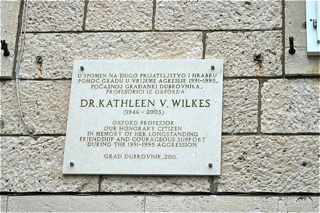
The formal unveiling ceremony was held on February 1st 2012 during the celebrations for the feast of Saint Blaise, Dubrovnik’s patron saint. It was attended by a select group of people, including children too young to have known the war, alongside some of Kathy’s old friends such as Mr. Pero Poljanić, Dubrovnik’s Mayor at the time of the siege; Mrs. Berta Dragičević, long-serving secretary of the Inter-University Centre; and Mrs. Tea Batinić, owner of the ‘Artur’ art gallery. Four prominent people spoke movingly of her achievements from different standpoints: the present Mayor of Dubrovnik Mr. Andro Vlahušić, the Town Council President Mrs. Olga Muratti, Inter-University Centre Director Prof.dr.Krunoslav Pisk, and Mrs. Flora Turner, Kathy’s successor as Chairman of the British-Croatian Society.
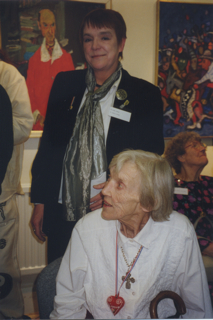
The ceremony began with the Croatian national anthem, ‘Lijepa naša Domovino’ (hymn to ‘Our Beautiful Homeland’). It is difficult to explain the emotions that the anthem evokes to those who have not lived through the long years of exile when Croatia and its culture were totally suppressed, the short period of hope when Croatia was established as an independent democratic country, and then the black years of a totally unexpected war of aggression on that newly emerged yet ancient unit. Twenty years on from the worst of the attack on our homeland, the younger generations are understandably as blasé about the anthem as their UK counterparts are about ‘God Save the Queen’. But for those of us who have lived through all the vicissitudes which finally led to the freedom to broadcast the Croatian anthem at full throttle without let or hindrance, the emotional impact remains strong, sometimes almost unbearable.
Challenges started early on in her life. She went up to Oxford as a Scholar at St. Hugh’s College, but after breaking her pelvis in a riding accident at the end of her first year she was unable to sit for long periods, so she did much of her studying and essay-writing standing up, using a mantelpiece for a desk. She achieved a Double First in Greats (Classics), with a Congratulatory First in her finals - not quite standing on her head, but creditably close.
She went on to study philosophy for three years at Princeton University in the United States under the mentorship of eminent academics like Thomas Nagel, who was born in Belgrade (Serbia) to a Jewish family, studied in the United States and Oxford (Corpus Christi), and later became Professor of Legal Philosophy at New York University. Kathy completed her doctorate on a one-year ‘external studentship’ at King’s College Cambridge, before applying to return to Oxford.
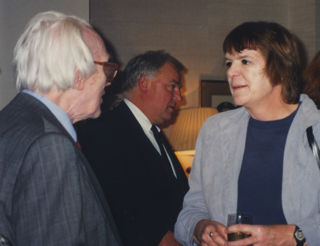
Having become a Fellow of St. Hilda’s in 1972 at the very young age of 26, she volunteered six years later to visit Prague, then behind the Iron Curtain, to give philosophy seminars, which were a dissident, therefore risky activity. She returned to then-Czechoslovakia several times, even after she had been refused a visa, and was tireless in helping Czech academics and students right up to the fall of the Iron Curtain in the ‘Velvet Revolution’ of 1989. Kathy also spent time teaching in the then-Soviet Union, Poland, Bulgaria, Brazil and China. She was unconditionally dedicated to her students and to providing and improving academic opportunities for as many people in as many places as possible. Her help was practical, wide-ranging and personal: she brought the philosopher Julius Tomlin and his family out of Czechoslovakia to safety, organized student visits in the UK (even funding some of those in greatest need), and supplied academic journals and literature to dissidents and later on to nascent academic institutions.
She had a special gift for creating close friendships, not just through her undoubtedly charming character, but by dint of being prepared to help people on every level of their lives. At St. Hilda’s, she was appointed Dean in the early 1980s by the Principal Mary Moore, who later commented in Kathy’s obituary in the College Chronicle ‘Needless to say, she made an excellent Dean’. Kathy also successfully pursued her own academic interests, publishing two well-received books, Physicalism (1978) and Real People (1988) as well as over 50 articles.
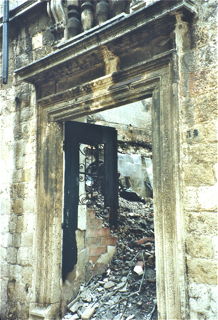 It was in former Yugoslavia that her courage and resources were put to the greatest test. She had become Chairman of the Executive Committee of Dubrovnik’s Inter-University Centre in 1986, and spent time teaching there every year, as well as co-editing with William Newton-Smith an academic journal first entitled ‘Dubrovnik Papers’ and later ‘International Studies in the Philosophy of Science’. Kathy was in Dubrovnik in 1991 when the Serb-led Yugoslav National Army suddenly attacked the city with ruthless, sickening aggression.
It was in former Yugoslavia that her courage and resources were put to the greatest test. She had become Chairman of the Executive Committee of Dubrovnik’s Inter-University Centre in 1986, and spent time teaching there every year, as well as co-editing with William Newton-Smith an academic journal first entitled ‘Dubrovnik Papers’ and later ‘International Studies in the Philosophy of Science’. Kathy was in Dubrovnik in 1991 when the Serb-led Yugoslav National Army suddenly attacked the city with ruthless, sickening aggression.For the 1996 -1997 edition of the St. Hilda’s chronicle, Kathy wrote a moving article about what life in Dubrovnik was like under siege from September 1991 to January 1992. Her personal account evoked the full horror of the relentless attacks from air, sea and land against one of the most beautiful historical holiday resorts in the world. No journalist’s report ever matched her descriptions in bringing home the full extent of the tragedy. On October 3rd 1991, Kathy spoke with calm determination to the BBC World Service for their ‘Topical Reports’ programme: ‘There’s no water. There’s no electricity. This is the only phone in Dubrovnik. There’s fire all around. I think nobody including the Croatian President knows the extent of the damage here. The houses are on fire. About a quarter of Dubrovnik and the suburbs have been destroyed.’ That was two months before the specially brutal aggression on December 6th 1991, the feast of St. Nicholas which marks the start of Catholic Christmas celebrations.
Kathy stayed in the city, helping the local people in every way possible, and sharing the misery and deprivations of the experience, the daily danger of death. There was no running water or electricity, and it became bitterly cold from November onwards. Kathy had been swimming in the sea for toileting and bathing purposes, but gave that up after meeting a floating corpse. She stayed with Mrs. Tea Batinić, owner of the art gallery ‘Artur’, and left only to collect aid to bring back to the city, travelling under very difficult circumstances. Tea recounted how on one occasion, sailing out of Dubrovnik, Kathy found a young man hiding in her cabin, who begged her not to give him away, as he could not cope with the stress of the siege any more. Of course she helped him escape.
Far-sighted positive thinking, practical help
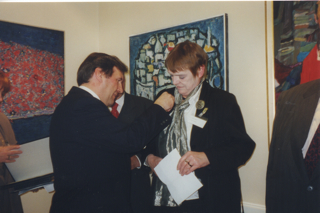
While in the United Kingdom, Kathy found time to lend her support to the Croatian Peace Forum, a small group of some thirty volunteers who were dedicating their spare time to publicizing the truth about the war in Croatia and (from 1992) Bosnia-Hercegovina, as well as collecting and distributing aid for the war victims. Besides being brilliant academically, Kathy was always very practical: she would come to the UK with a list of necessary supplies and medicines, acquire them and return. One big gift was an ambulance donated through Franka’s Fund for Croatia, a charity run by Baroness Franka Stael von Holstein, fashion designer to the elite. Kathy drove the ambulance all the way to Dubrovnik, exciting awe and admiration as much for her skill in driving a right-hand-drive vehicle on left-hand-drive roads as for her courage in travelling through the danger zones. Later on she would take in mine detectors when the area around Dubrovnik could be cleared. On one occasion when flights had been restored, we travelled out of Heathrow airport together, and I marvelled at her fearless determination as she marched through customs with her precious cargo.
Physical adversity never deterred Kathy or caused her a moment’s fear. One of her mine detectors injured her leg when she decided to test it out, but she dismissed the incident as trivial. Once she was attacked in an alleyway in Oxford, apparently by a Serb, who knocked her to the ground, breaking her arm, and then drew the Serbian logo on her skin. Despite the inconvenience of being in plaster and in pain, Kathy expressed no complaint or anger against her assailant. Her personal safety and comfort were never her priorities. (Fortunately, such incidents were rare, as Special Branch officers kept a close watch on the communities of former Yugoslavia, especially in London, issuing immediate warnings and taking discreet action if trouble seemed to be brewing. This was reassuring for the minority groups: at the time of the aggression there were some 30,000 Serbs in the UK, compared to 2,000 Croats and even fewer Bošniaks, Macedonians and Kosovars.)
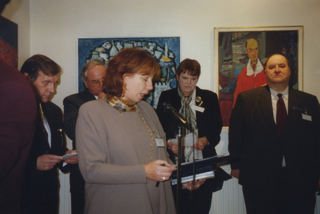
Kathy’s thinking was always moving forwards, constantly attuned to practical needs, and not just in her immediate environment. Writing after the 1995 Dayton Peace Accord, she described how refugees were still crammed into Dubrovnik’s surviving hotels, and the outlying villages were totally devastated, but she emphasized that the disaster of Vukovar was much worse, with that city suffering more in the aftermath of the war than Dubrovnik, but without the international sympathy focussed on the latter.
Gratitude and recognition
Kathy received several honours for her courage, tenacity, vision and unstinting help: Croatian President Franjo Tudjman granted her one of Croatia’s highest awards (Red Danice hrvatske – the Order of the Morning Star) in 1997; she was made an honorary member of the Croatian Army; she was given an honorary doctorate from the University of Zagreb; while President Vaclav Havel awarded her the Commemorative Medal of the President of the Czech Republic in 1998. The honour she undoubtedly prized most was the honorary citizenship of Dubrovnik, which was granted in 1993. Kathy was the first of only five people to be honoured by the city in this way in the newly independent state of Croatia, the others being Ivan Supek (1997), Pope John Paul II (2003), Christopher Patten (2004) and former Croatian President Stipe Mesić (2009).
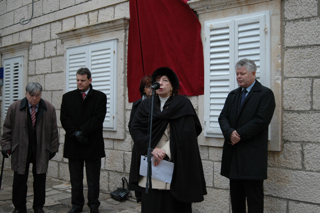
After her death, Kathy’s ashes were scattered in the sea under the Lovrijenac fortress. The dedication of the nearby square on the Pile bay to her memory, twenty years after the time she helped the city in its greatest hour of need, is a perfect tribute to the lady known throughout Dubrovnik as ‘Naša Keti’ – ‘Our Kathy’. It was particularly fitting that Flora Turner was able to attend the unveiling ceremony and speak about her friend Kathy Wilkes. As a reporter on the BBC World service in 1991, Flora introduced Kathy’s first message from besieged Dubrovnik to the world’s listeners; as one of the founders of the Croatian Peace Forum, Flora helped to coordinate some of Kathy’s requests for aid; as Cultural Attaché to the Croatian Embassy in London in 1998, Flora gave a speech congratulating Kathy when she received the Red Danice hrvatske; and in 2012, as Kathy’s successor as chairman of the British-Croatian Society, Flora was able to demonstrate how Kathy’s life of courageous service had achieved its highest aims: the victory of love, culture and reason over primitive savagery and greed.
Links to videos from Dubrovnik, February 1st 2012: excerpts from the speeches by Mayor Andro Vlahušić and Mrs Olga Muratti (in Croatian); part of Flora Turner's speech (with sub-titles in English)
Note: to see the photo titles, hover your mouse over the image
© Vivian Grisogono 2012. Updated 2014


